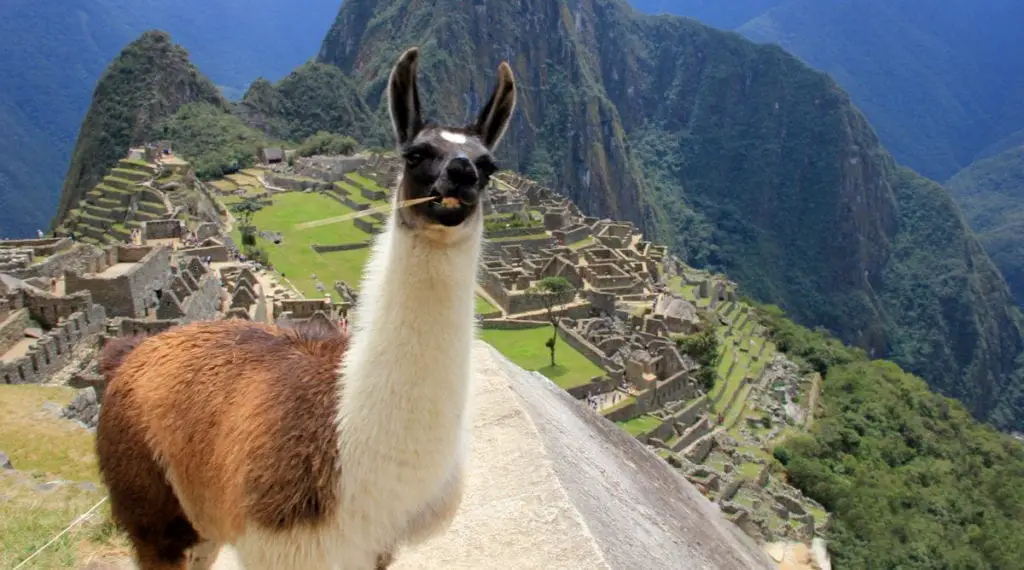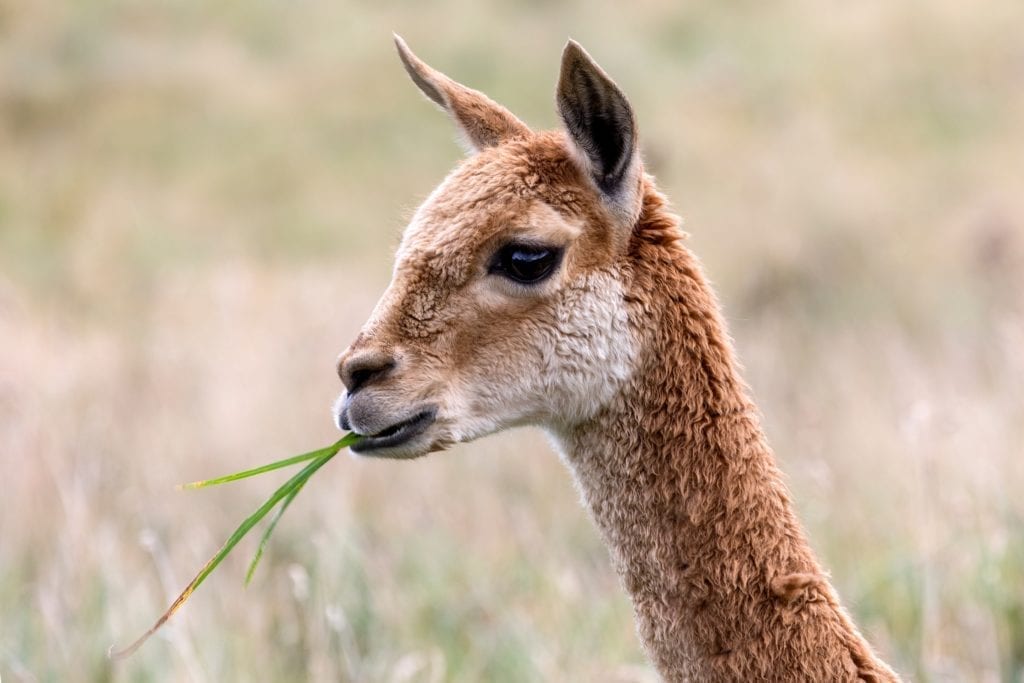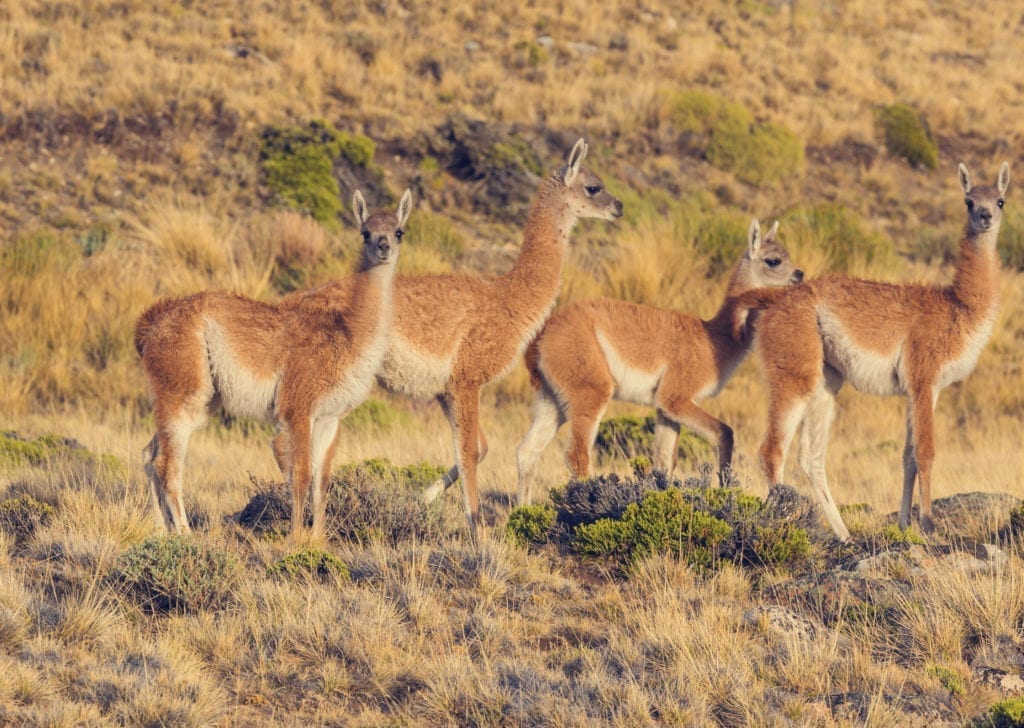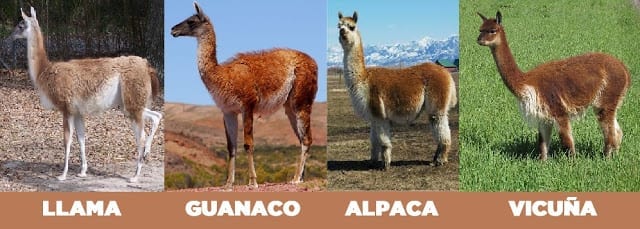What Is The Difference Between Llamas and Alpacas?
James Bustamante is Native to New York but born to Peruvian parents. He has been traveling throughout Latin America since early 2003 and finally made his home in Peru. James has made his way by eating and traveling through almost every country in Central and South America.
Last Updated on December 5, 2023 by James Bustamante
So What’s the difference between Llamas and Alpacas? This difference will be the roundness of their face, their size and weight, the type of coat they offer, the shape of their peculiar ears and lastly would be their temperament.
The country of Peru is usually associated with a few things. These include the Machu Picchu hike, delicious food, and of course the Llama. This famous camelid has been featured in anything and everything from postcards to ugly Christmas sweaters.
So basically the Llama is on everyone’s mind when they visit Peru for the first time. Did you know that it is in fact the Vicuna and not the Llama the animal featured in the Peruvian flag?
The vicuna is also a member of the camelid family however it is actually a much smaller and elusive animal. Think of them both as distant cousins. To this list of Andean camelid family members, we can add Guanaco as well. This makes four camelids you’ll find in Peru: The Vicuna, The Alpaca, The Llama, and The Guanaco.
There is usually quite a bit of confusion in regards to all of these animals, to the naked eye they might all look the same. Let’s go over some of the details that differentiate the difference between Llama and Alpacas as well as their cousins the Vicuna and the Guanaco.
Difference Between Llamas & Alpacas!
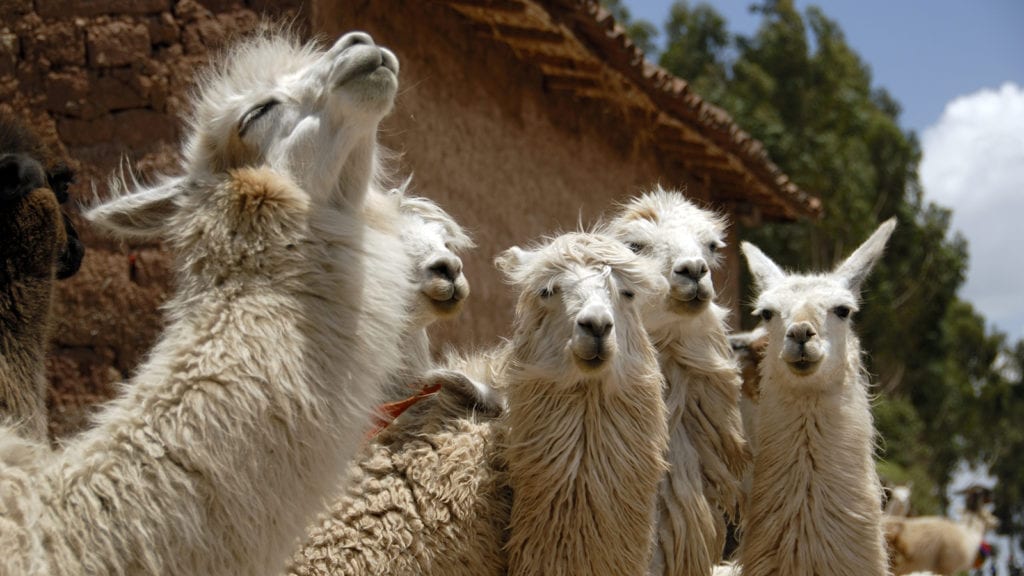
There are a few key physical attributes that differentiate the Llama from the Alpaca. It’s true though. For the average person, it can be very difficult to set them apart but with our comprehensive guide below you will be an expert in no time at all.
They Have Different Ears!
Another clear difference between Llamas and Alpacas is in their face. Look at their ears and you will clearly see the different shapes as well as the length. Alpacas will have much shorter and pointy ears while the Llama will have a longer ear that is shaped kind of like a banana.
In this aspect, the difference between Llamas and Alpacas is quite apparent. Many times when our guides head Machu Picchu group tours through the Andes the first thing they hear from trekkers when comparing these two camelids is the size and shape of the ears!
Travelers Tip: If you are looking for a hike where you will see plenty of Inca monuments as well as locals herding their Llamas and Alpacas try the 4 day Inca trail to Machu Picchu.
Different Sizes
The most obvious difference between Llamas and Alpacas would have to be their size. It is a telltale sign of what camelid you are looking at. The Llama is almost 2 times the size of the smaller Alpaca. The heavier Llama can weigh upwards of 350 lbs or around 150 kg for the metric system folk. Some Llamas can be even heavier.
The Alpaca can weigh from 100 to 180 lbs (45 – 68kg), a considerably smaller animal. Llamas are taller than their Alpaca counterparts. They measure around 42-46 inches at the withers (110 cm). The shorter Alpaca comes in at no more than 36 inches at the withers (90 cm).
Difference Between Llamas and Alpacas in The Face
The larger Llama will have a longer face than the Alpaca. The smaller Alpaca’s face will seem more compact and not as pronounced. In general, Alpacas will have more facial hair than the Llama, this aids in showing their more rounded face.
Look at The Coat
When trying to spot the difference between Llamas and Alpacas try looking at the fibers. You can usually spot the difference between these two camelids depending on the animal’s fluff factor.
The Alpaca is a much fluffier animal in comparison to the larger Llama whose coat will seem coarse. They do have a fine undercut though, you will probably not see this until you are very close up to them though.
Different Temperament
This can be a challenge at first glance but both of these animals do have a different temperament. Now, this can vary from animal to animal however just like many things, the key is in what is consistent.
Llamas will usually be a bit more skittish and independent, they hesitate to protect themselves if they feel threatened. Farmers will actually keep Llamas to protect other livestock in the Andes mountains.
Llamas are ok with other animals but will generally prefer to be left alone. They really don’t have many natural predators to speak of other than cougars and even then the Llama is a 400 lbs animal.
Alpacas are more of a herd animal, they will also be rather skittish if needed but in general just a bit friendlier than your average everyday Llama.
So this begs the question, do Alpacas spit just like a Llama? Well, yes they do but not as often. It’s the way camelids tend to defend themselves. Llamas will spit on a more regular basis, though.
Purpose & Uses
These Andean camelids have been a domesticated bunch for over 5,000 years. Both the Llama and the Alpaca have been bred for different users all around the Andes. For example, a big difference between llamas and alpacas come back to the fur. Since Llama fur is not as soft as the Alpacas, Llamas tend to be used more for their meat.
This isn’t to say Alpacas aren’t also used as a source of protein (which they are). The much larger llama is also used as a pack-carrying animal throughout the Andes. They can carry a quarter of their own weight rather easily. The alpaca, which is a much woollier animal, is bred for its fibers which are used to make luxury items. An alpaca sweater can easily cost $150 and they are well worth it.
Finding Llamas and Alpacas
If you are searching for either of these camelids then look no further than South America. For the llama, you will head over to the Andes where they thrive in high elevation areas. Llamas can be seen all throughout Peru, Bolivia, Argentina, and even as far south as Chile. The Alpaca is more central to Peru and can be found on the southern end of the country.
They can also be spotted in other countries like Chile, Bolivia, and Ecuador but this species originated in Peru.
Travelers Tip: If you want to look into all the different methods of getting from Lima to Machu Picchu then look no further.
Remember that there are great destinations in between like Cusco, The Sacred Valley, The Nazca lines, and several more.
One of the biggest questions we get from groups heading to their Machu Picchu tours is “Will we see Llamas in Machu Picchu?”. The answer is og course a resounding “YES!”
Once in Machu Picchu, you will find Llamas just lounging around the side minding their own business doing well, Llama things.
No worries since these particular Llamas are very much acquainted with humans so there will be no spitting.
Vicuña & Guanaco
There are two other species of camelids you will find in Peru. They can also confuse the average traveler when trying to tell them apart. These two gorgeous creatures are called the Vicuña and the Guanaco.It has been generally believed that the Guanaco is the undomesticated version of the well known Llama. The same can be said over the Alpaca emanating from the wild Vicuña.
Both of these animals live very high in the Andes and since they are more elusive than their domesticated counterparts, much more difficult to spot.
The Vicuña
The vicuña has been linked to the Alpaca. The vicuña is quite small in comparison to the other camelids on this list. It tends to resemble a deer due to its slender body. This camelid will weigh around 150 lbs or around 68 kg. At the withers, the vicuña will measure around 33 inches or 75 – 85 cm. The vicuña is known throughout the world for its super soft fibers.
It is actually one of the most south after fleeces in the world. The quantity that comes from just one vicuña equals just one pound of fiber, this makes it one of the rarest fibers you can find.
The vicuña is actually an endangered animal due to the overhunting that took place for many years. This camelid was once a protected species by the Inca, that however changed once the Spanish conquistadors arrived.
After many years of protecting these small animals, hunting has been finally outlawed. It is still permitted to shear vicuñas but only a certain amount each year.
They are of course released after they have been sheared. You will be able to find these little animals in the highlands of Peru as well as Bolivia, Ecuador, and even further down south in Argentina and Chile.
The Guanaco
The Guanaco is smaller than its domesticated version (The Llama) but it has rather similar characteristics such as the rough outer coat and the much softer undercoat.
This animal comes in weighing at around 200 lbs or 90 kg. The guanaco will have a peculiar color emanating a brownish backside with a lighter white underbelly while the guanaco’s face will most likely be a grey color.
Its ears are also smaller and have a more square shape to them. On the other hand, the domesticated Llama comes in a much broader color palette.
The Guanaco also falls under the protected species catalog since it has also been the victim of overhunting throughout the years.
The damage to the population was not nearly as bad as it was with the smaller vicuna. The Guanaco coat naturally being more coarse makes it a less desired fiber. You will find Guanacos all around South America with big populations residing in Patagonia (Argentina), Ecuador, Colombia, Tierra del Fuego, and even the extremely dry Atacama desert.
Remember Guanacos are camelids just like well, camels, so they can get by quite well with very little water.
Differences Among Andean Camelids
If you aren’t particularly sure and can’t tell the difference between llamas and Alpacas as well as Guanacos and Vicuñas then you can go by size.
The general size guide is as follows from biggest to smallest: Llama – Guanaco – Alpaca – Vicuña. Next, you will need to check on the color scheme and pattern each species is known for. The Llama will come in a variety of different colors however they will also have a marked coat. Meanwhile, the Alpaca will have a more uniform color.
If we refer to the Guanaco we notice it has a very distinctive coloring of a brown back with a grey face and white undersides. The Vicuña on the other hand will have a yellowish face with shades of brown here and there.
The Guanaco has distinctive coloring, with a brown back, grey face, and white undersides. The Vicuña’s face is a yellow/reddish brown. One last piece of data that might help you tell the Vicuña apart from the rest is that their eyes will look too big for their head.
The Fiber Guide
Peru houses the world’s largest population of Alpacas, this is close to 80% of all the Alpacas out there. Their highly-priced fibers are sold in the international textile industry, this happens to be one of Peru’s most important economic sectors. Peru is known throughout the world for its extremely soft cotton and its luxury Andean fibers.
We urge travelers to check out the Andean communities and their products which are always of extremely high quality. Imagine coming to Peru and not checking out Alpaca, baby Alpaca, or Vicuña products with Andean wholesalers?
Well, before going out and purchasing all the Alpaca sweaters you see check out the guide to these luxurious fibers.
Llama Fiber
When it comes to the llama we can say it has two coats. The first is the soft undercoat which is typically used for very fine garments.
The second is the protective outer coat which is coarse and thick, this fiber is normally used for items such as rugs and ropes.
The llama fiber is not easily processed, the vast difference between the tough outer and pillowy undercoat make it necessary to go through a tedious process of separation.
Guanaco Fiber
The Guanaco’s fiber is considered to be superior to the llama’s because it is a much easier fiber to process in comparison.
This camelid equally has two coats, a more coarse outer layer and a soft undercoat which is easier to access than on the llama. The color of this soft fiber is a caramel color.
Alpaca Fiber
The fiber you will find on the alpaca is generally speaking a very dense fleece that will need to be shorn during the summer season.
It grows back very quickly so a brand new fleece will be ready by the time winter sets in.
The fiber has all the qualities you would want in comfortable clothing items.
It is strong and durable as well as soft and lightweight. Alpaca fiber is also priced for how it can be used as a luxurious thermal fabric that also happens to be hypo-allergenic.
If we want to get down to specifics then there are basically two very important sub-types of Alpaca which have different hair.
There is the Huacaya Alpaca which boasts a short, sheep-like, and full fiber, The Suri Alpaca has, on the other hand, produces a longer fiber due to its long coat.
Travelers Tip: If you are looking for Alpaca products rest assured that garments coming from both Alpaca species are first class. However if you can spend the extra cash as for Suri Alpaca, this species is rarer and its fibers are more prized.
Baby Alpaca Fiber
Now we are getting to the more luxurious fibers on this list. Baby Alpaca is a type of fiber that comes from the first shearing when the Alpaca is younger than one year. This first shearing comes specifically from under the neck and the belly. This is where the softest fiber on the alpaca comes from. Here you will find a light, soft, very fine fleece measuring 21 microns in diameter.
This fiber tends to be very expensive so you will commonly find a blend consisting of baby alpaca fiber and sheep’s wool.
Royal Baby Alpaca Fiber
This fiber is in a category of its own. Royal Baby Alpaca has fibers that measure under 20 microns, making it one of the most expensive (and softest) in the world.
Vicuña Fiber
The fiber coming from these small camelids is the best in the entire world. The fiber is very fine, soft, and with superior quality to anything else. Even cashmere pales in comparison to vicuña fiber. Yes, it is also quite expensive but that comes with the territory.
The Inca only allowed royalty to wear vicuña, it was and is still considered a sacred animal to the Inca’s descendants. This small creature is rare even to the locals. It also produces very little fiber every year making it’s wool even more exclusive.
More On Fibers
The Vicuña and the Alpaca are two different types of Andean camelids that are valued for their high-end fiber. While the Alpaca’s fiber is considered one of the best and is extremely high in quality the Vicuña’s coat is of a superior standard.
It is the most expensive of these fibers and was traditionally only worn by Inca royalty. Everyone that has worn Vicuña swears it is the most unbelievably special, fine, and soft fiber they have ever touched.
The Alpaca produces a more accessible fiber, it was actually bred for this specific purpose so it makes sense.
Its coat is however fiber than the Llama which has a rough outer coat and a softer undercoat. Separating both of these types of fibers involves a long process. This same idea applies to the Guanaco, it has two coats, a soft undercoat, and a more coarse overcoat.
The Guanaco, however, produces fiber of higher quality than the Llama however it is very difficult to find.
Alpaca Products
Fibers from the Alpaca are much softer and lighter than something like cashmere or sheep wool; they are also stronger. Alpaca wool holds fewer allergens, dust, and bacteria than something like sheep wool and it does not feel prickly against your skin.
The Alpaca also has a few natural colors and shades to choose from including white, grey, brown, and even a stylish black. Alpaca fiber is also a more sustainable product when compared to something like cashmere.
Alpacas being camelids and all, consume less water than farm animals and produce loads of wool, enough to make several sweaters in one shearing season.
The Myriad of Alpaca Products
There are several products made from Alpaca, Baby Alpaca and Royal Baby Alpaca available for purchase.
These include blankets, toys, sweaters, ponchos, scarves, etc. There are also several colors and designs to choose from.
Buying Alpaca Products
You can purchase Alpaca products at any local artisan shop in Peru. You will come across many different products, colors, and designs. We can include a trip to Pisac Market in your Machu Picchu travel package, this is located around one hour from Cusco.
This market is commonplace for indigenous folk to sell their Alpaca products. You can buy directly from the same people who raise and shear the Alpaca as well as make the actual garments.
If you happen to be in Lima, try visiting the Inka markets in Miraflores near Petit Thouars Avenue. You’ll find stores like Sol Alpaca and Kuna which specialize in these garments, you might even find a Vicuña scarf if you are lucky.
Word to the warry, buying these products in Lima will most likely mean paying a higher price. The quality when purchasing in these stores is 100% guaranteed though.
Prices For Alpaca Products
Here is some additional information on pricing for purchasing Alpaca products:
Blended Alpaca products are not as expensive as 100% pure versions. Look for prices starting at $15 for something like a scarf or a sweater.If you are looking for 100% pure Alpaca then pricing should be upwards of $60 – $80 US and even up to $200 US in the more expensive, upscale stores.
Baby Alpaca is a more prized fiber and items will usually start at $100 each. Small items like gloves or socks (these are especially comfortable in the winter) pricing will be slightly cheaper.
Alpaca Shopping Tips
Peru is an amazing place with amazing people but remembers that everyone is trying to make a living. Here are some tips to help you when purchasing your Alpaca products.
Remember to write down pricing from each vendor so you can compare appropriately.
If you are looking for some of the highest quality, try going to the Kuna or Sol Alpaca stores first to at least get an idea of how expensive these garments can get.
Once you hit the markets, you’ll know if the vendors are charging too much if they equal one of the high-end store’s pricing.
While you are at the luxury stores make sure to get a correct feel for the high-end products for comparison.
There is always the chance that one you get to the less expensive markets, vendors state the products have more Alpaca in them than they actually do.
If the plan is to head to the market to save some money on your Alpaca products check if the item is a blend of Alpaca, wool, or some other synthetic material.
All Alpaca products should be cool to the touch, this is a general rule of thumb when comparing the fibers.
If you see sparkly fibers in the garments then that is a telltale sign of a blended piece so hold them up to the light so you can check.
Baby and Baby Royal Alpaca are more expensive fiber and harder to find as well.
Be cautious of vendors claiming this fabric if they pile on too many products made from this fiber.
Most products made from Baby and Baby Royal Alpaca will be very soft and something you wear very close to your skin.
If you place this product on your skin does it irritate or chafe? If it does, then it is probably a blend or not, baby Alpaca. Never buy the first product you see and feel. Remember to shop around and get a feel for the products.
Bargaining and haggling are common in Peru and even more common with Alpaca vendors so don’t be afraid to offer less than what the vendor is asking for. Just make sure not to offend with your counter-proposal. If there is one last piece of information we can provide is to not buy Alpaca products in places like Aguas Calientes or in Machu Picchu.
Pricing will be much higher than it should be so wait until you are back in Cusco, head to Pisac, or even in Lima.
In Conclusion
We hope this article explaining the differences between Llamas and Alpacas has been informative for the reader. If you have any other questions about these camelids or would like to make your Machu Picchu reservations, book a trip or have any questions.Remember that our expert travel advisers are currently standing by.
Frequently Asked Questions about Llamas and Alpacas?
Is a Llama different from an Alpaca?
Yes, both of these animals are Andean camelids, but they are completely different species.
Is Alpaca fiber more expensive than Llama fiber?
Yes, the fiber from the Alpaca, Baby Alpaca, and Royal Baby Alpaca are more expensive than Llama fiber
Do Llamas and Alpacas spit?
Yes, both of these animals will spit if they feel threatened. The Alpaca is however a more docile animal, while the Llama can be a bit more aggressive.
Where can I find Alpaca products?
There are several places to find Alpaca products in Peru. You can try the high-end stores like Kuna or Sol Alpaca or try some of the more affordable vendors in Cusco, Arequipa, and Puno who raise, shear, and create the Alpaca products.
How much do Alpaca products cost?
This varies depending on if the product is 100% Alpaca or if it is a blend of fibers. If the product is a baby or royal baby Alpaca, then it will be more expensive. Prices can vary from $10 to well over $200 for a sweater made with top-quality fiber.
Which animal produces the softest and most expensive fiber?
The crown would have to go to the Vicuña. This animal is rare, and it produces a very small yield. The fiber is also softer than cashmere.


